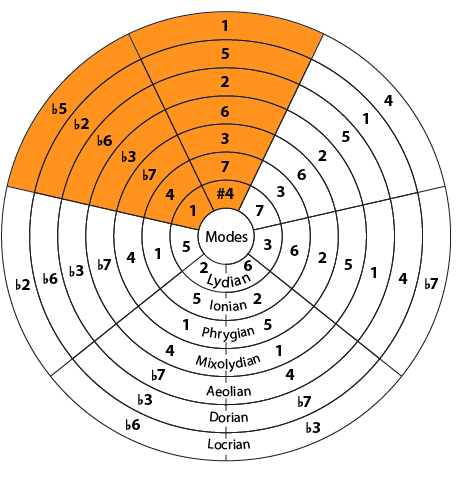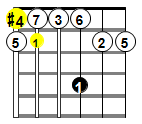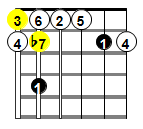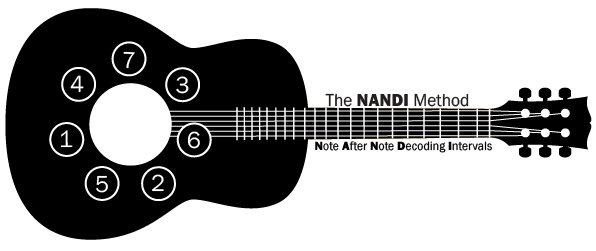A mode is derived by building a scale from each degree of the major scale.
We can find seven modes in western music, all of which originate from each of the seven degrees of the major scale.
In the key of C Major, the modes include:
- C Ionian
- D Dorian
- E Phrygian
- F Lydian
- G Mixolydian
- A Aeolian
- B Locrian
Modes share the same notes as the parent scale that they are derived from. The difference between a mode and a parent scale is the root and the intervallic structure.
For example, if we play D Dorian, we are really playing the C Major scale starting from the note D, which is the root of the scale.
Watch the video below to learn how to identify the intervals in the seven modes of the major scale using the Circle of Fourths:
Take a look at the Circle of Modes below.
If we move clockwise beginning from the 12 o’clock position in the circle, we will find the seven intervals for each mode arranged in fourths. The names are indicated within their respective circles.
The two wedges that are shown in yellow indicate the tritone intervals within each mode.
For example, ♭5-1 in the yellow shaded wedges, which is found within the outermost circle, indicates the tritone intervals that are found within the Locrian mode.

Using the Circle illustration above, we can for example, learn the intervals in the Lydian mode (innermost circle) in the order of fourths. Starting from the 12 o’clock position and moving clockwise, we will find that the intervals #4-7-3-6-2-5-1 in Lydian can be visualized on the fretboard as shown below.

The third circle from the center displays the intervals found in the Mixolydian mode. Starting on 3 at the 12 o’clock position and moving clockwise, we can easily learn the 3-6-2-5-1-4-♭7 order of intervals on the fretboard. See below:

The Lydian, Ionian, and Mixolydian modes have a major third interval in their tonic chord and are called major modes.
The Dorian, Aeolian, and Phrygian modes have a minor third interval in their tonic chord and are called minor modes.
The one diminished mode with a flat-fifth in the tonic chord is the Locrian mode, which we can see in the outermost circle.
Learn 6 chords from 6 modes using the same shape:
Listed in the table below, are intervals in the various modes from which you will find 4 types of seventh chords: major seventh (e.g. Cmaj7), minor seventh (e.g. Cm7), dominant seventh (e.g. C7) and minor seventh-flat-five (e.g. Cm7♭5). You will find that all modes will have the same seventh chords, meaning each mode has two Major Seventh Chords, three Minor Seventh Chords, one Dominant Seventh chord, and one Minor Seventh flat-five. In the key of C, the only minor seventh-flat-five chord is from B, minor seventh chords are from notes E, A and D, the dominant seventh chord is from G, and the major seventh chords are from C and F. Notice the fourth order I have listed these chords-B–E–A–D–G–C–F.
| 1 | 2 | 3 | 4 | 5 | 6 | 7 | 1 | Ionian 1-2-3-4-5-6-7 | |||||||||||||||
| C | D | E | F | G | A | B | C | ||||||||||||||||
| M7 | m7 | m7 | M7 | 7th | m7 | m7♭5 | M7 | ||||||||||||||||
| Dorian 1-2-♭3-4-5-6-♭7 | 1 | 2 | ♭3 | 4 | 5 | 6 | ♭7 | 1 | |||||||||||||||
| D | E | F | G | A | B | C | D | ||||||||||||||||
| m7 | m7 | M7 | 7th | m7 | m7♭5 | M7 | m7 | ||||||||||||||||
| Phrygian 1-♭2-♭3-4-5-♭6-♭7 | 1 | ♭2 | ♭3 | 4 | 5 | ♭6 | ♭7 | 1 | |||||||||||||||
| E | F | G | A | B | C | D | E | ||||||||||||||||
| m7 | M7 | 7th | m7 | m7♭5 | M7 | m7 | m7 | ||||||||||||||||
| Lydian 1-2-3-#4-5-6-7 | 1 | 2 | 3 | #4 | 5 | 6 | 7 | 1 | |||||||||||||||
| F | G | A | B | C | D | E | F | ||||||||||||||||
| M7 | 7th | m7 | m7♭5 | M7 | m7 | m7 | M7 | ||||||||||||||||
| Mixolydian 1-2-3-4-5-6-♭7 | 1 | 2 | 3 | 4 | 5 | 6 | ♭7 | 1 | |||||||||||||||
| G | A | B | C | D | E | F | G | ||||||||||||||||
| 7th | m7 | m7♭5 | M7 | m7 | m7 | M7 | 7th | ||||||||||||||||
| Aeolian 1-2-♭3-4-5-♭6-♭7 | 1 | 2 | ♭3 | 4 | 5 | ♭6 | ♭7 | ||||||||||||||||
| A | B | C | D | E | F | G | A | ||||||||||||||||
| m7 | m7♭5 | M7 | m7 | m7 | M7 | 7th | m7 | ||||||||||||||||
| Locrian 1-♭2-♭3-4-♭5-♭6-♭7 | 1 | ♭2 | ♭3 | 4 | ♭5 | ♭6 | ♭7 | 1 | |||||||||||||||
| B | C | D | E | F | G | A | B | ||||||||||||||||
| m7♭5 | M7 | m7 | m7 | M7 | 7th | m7 | m7♭5 | ||||||||||||||||
| www.thenandimethod.com |
